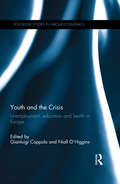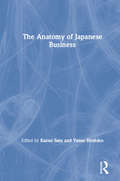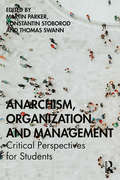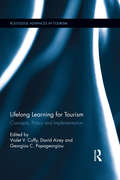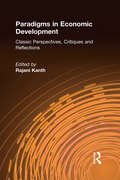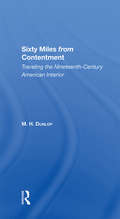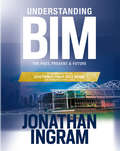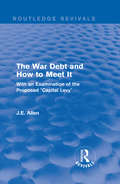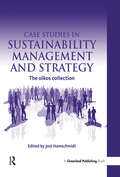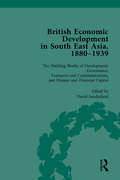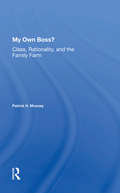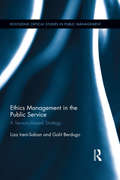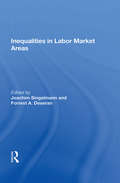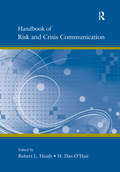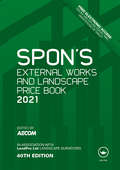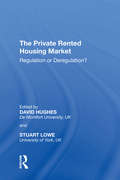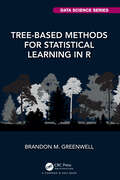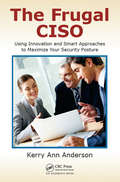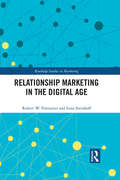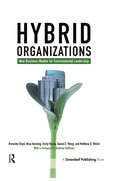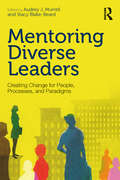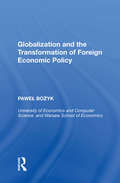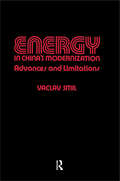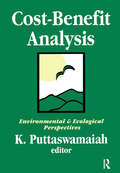- Table View
- List View
Youth and the Crisis: Unemployment, education and health in Europe (Routledge Studies in Labour Economics)
by Niall O'Higgins Gianluigi CoppolaThe recent recession has led to an ongoing crisis in the youth labour market in Europe. This timely book deals with a number of areas related to the context, choices and experiences of young people, the consequences of which resonate throughout their lives. The focus of the contributions to this volume is on issues which, whilst undoubtedly important, have thus far received less attention than they arguably deserve. The first part of the book is concerned with issues related to education and training, covering matters such as the role of monopsony in training, the consequences of over-education, and the quality of educational institutions from primary to tertiary. The second part is primarily concerned with the long-term consequences of short-term choices and experiences including contributions on health-related choices, health consequences later in life, factors affecting the home-leaving decision, as well as an analysis of the increasing intergenerational transmission of inequality; a trend which accelerated during the recession. The last part of the book deals with issues related to youth unemployment and NEET – the direct consequence of the recession. This book contains a number of innovative analyses reporting significant findings that contrast with standard models. Some of the more interesting results directly contradict conventional wisdom on a number of topics from the importance of monopsony in training markets to the importance of transitory income changes on consumption of addictive goods. This book is suitable for those who study labor economics, political economy as well as employment and unemployment.
Anatomy of Japanese Business
by Kasuo SatoThis volume collects eleven essays written by Japanese experts on various aspects of Japanese business management and is a sequel to the volume Industry and Business in Japan. It examines the mechanisms for Japan 's phenomenal economic growth since the Second World War by analyzing Japanese management, business groups, production systems and business strategy.
Anarchism, Organization and Management: Critical Perspectives for Students
by Martin Parker; Konstantin Stoborod; Thomas SwannYou might think that anarchism and management are opposed, but this book shows how engaging with the long history of anarchist ideas allows us to understand the problems of contemporary organizing much more clearly. Anarchism is a theory of organizing, and in times when global capitalism is in question, we need new ideas more than ever. The reader of this book will learn how anarchist ideas are relevant to today’s management problems. In a series of student-friendly short chapters on contemporary topics, the authors challenge the common sense that has allowed particular forms of organization and market to become globally dominant. Do we always need leaders? Is technological change always a good thing? Are markets the best way to arrange forms of exchange? This challenging book is essential for anyone who wants to understand what is wrong with business school theory and what we might do about it. For students and teachers of management, the standard textbook reproduces the dominant ideas about the way that business should be done. This book turns those ideas on their head, asking awkward questions about authority, technology and markets and demanding that its readers think hard about whether they want to reproduce those ideas too. Students of management, like everyone else, know that the current global system is broken but they don’t know what they can do about it. This unique book uses 200 years of anarchist ideas to give readers a clear guide for building the organizations and businesses of the future and places choice and responsibility at the centre of making a new world for people and the planet.
Lifelong Learning for Tourism: Concepts, Policy and Implementation (Advances in Tourism)
by David Airey Violet V. Cuffy Georgios C. PapageorgiouSince the middle of the last century tourism has demonstrated almost continual growth, with international tourist arrivals now recorded in excess of one billion per annum. Given the global socio-economic significance of tourism, it is imperative to develop educational opportunities for those working in tourism-related industries. These opportunities should fulfil the changing needs of both industry, travellers, and the learners themselves. While the concept of lifelong learning in the tourism industry plays an important role, it has received little academic attention to date. This book provides a theoretical overview of lifelong learning for tourism, exploring its history, practice, and conceptualization. It demonstrates the importance of lifelong learning for tourism from a variety of perspectives, drawing on educational, industry, policy, and socio-economic insights. The book explores managerial and political implications, critical issues, best practice examples, and draws on a range of international case studies to demonstrate theory in practice. Finally, it offers a conceptual framework for future curriculum approaches. This book will be of interest to students, scholars, and practitioners of tourism studies, hospitality, business and management, and international development. It will also appeal to those interested in adult education, vocational training, professional development, and pedagogy.
Paradigms in Economic Development: Classic Perspectives, Critiques and Reflections
by Rajani K. KanthPresents an introduction to East Asian politics. This book uses a thematic approach to describe the political development of China, Japan, and Koreas since the mid-nineteenth century and analyzes the social, cultural, political, and economic features of each country.
Sixty Miles From Contentment: Traveling The Nineteenth-Century American Interior
by M. H. DunlopSixty Miles from Contentment is a revitalization of a pulsating American scene in the nineteenth-century. Drawing on the work of travel writers from America's own East Coast and from fourteen other countries, it offers a witty and irreverent look at the wild Midwest in its heyday.
Understanding BIM: The Past, Present and Future
by Jonathan IngramUnderstanding BIM presents the story of Building Information Modelling, an ever evolving and disruptive technology that has transformed the methodologies of the global construction industry. Written by the 2016 Prince Philip Gold Medal winner, Jonathan Ingram, it provides an in-depth understanding of BIM technologies, the business and organizational issues associated with its implementation, and the profound advantages its effective use can provide to a project team. Ingram, who pioneered the system heralding the BIM revolution, provides unrivalled access to case material and relevance to the current generation of BIM masters. With hundreds of colour images and illustrations showing the breadth and power of BIM, the book covers: The history of BIM What BIM is in technical and practical terms How it changes the day to day working environment Why we need BIM and what problems it can solve Where BIM is headed, particularly with regards to AI, AR, VR and voice recognition International case studies from a range of disciplines including: architecture, construction management, and retail Professionals and students in any field where the inter-disciplinary aspects of BIM are in operation will benefit from Ingram’s insights. This book is an authoritative account of and reference on BIM for anyone wanting to understand its history, theory, application and potential future developments.
Routledge Revivals (1919): With an Examination of the Proposed "Capital Levy"
by J.E. AllenFirst published in 1919, this book traces the growth of War Debt during the First World War, examines the real meaning of the Debt and discusses the proposals for clearing it. As the chief contemporary proposal put forward for meeting the interest and repaying the principal of the Debt was the "Conscription of Wealth", or the "Capital Levy", this provides a main focus for the analysis. The author also examines whether the methods of financing war — by borrowing the required money — is sound and whether it should be replaced by taxation. A plan for the reform of income tax is put forward, designed to yield two-thirds of the revenue needed for a Peace Budget that also addresses the War Debt.
Case Studies in Sustainability Management and Strategy: The oikos collection
by Jost HamschmidtWith the rapidly growing importance of sustainability and corporate responsibility in a globalised world, management schools are increasingly integrating long-term economic, environmental and social issues into their teaching and research. Climate change, poverty, labour standards and human rights are among the many topics that future decision-makers will need to face in their careers. Business education needs to reflect this new reality and provide a broadened understanding of value creation in order to create economic capital while developing social and preserving natural capital. Many sustainability trends also offer interesting new business opportunities that are ripe for entrepreneurial thinking. Case studies can be important tools for creating learning processes on different levels - students are forced to struggle with exactly the kinds of decisions and dilemmas managers confront every day. In this reflection of reality, the values and goals of the student are systematically challenged. This can be especially valuable in the context of sustainability and strategy - organisations are now continually forced to value the different aspects of sustainability and their interrelations: How do social issues impact the economic bottom line? How can an environmentally sound strategy create a positive impact on employee motivation and thus have measurable impact on economic performance? What comes first and why? But excellent case studies for management education in the field of sustainability management and strategy are rare. This innovative collection has been produced to fill this gap. It is based on the winning cases of an annual competition organised by oikos - the international Student Organization for Sustainable Economics and Management. So what makes an excellent case in sustainability management? These cases have been highly praised because they provide excellent learning opportunities, tell engaging stories, deal with recent situations, include quotations from key actors, are thought-provoking and controversial, require decision-making and provide clear take-aways. These cases explore both the opportunities and pitfalls companies and NGOs face in targeting sustainability issues and how their values and core assumptions impact their business strategies. They deal with a myriad of issues including supply chain management, stakeholder dialogue, social entrepreneurship, sustainable marketing, ethics, governance, the business case for sustainability, partnerships, purchasing and climate change. Case Studies in Sustainability Management and Strategy is an essential purchase for educators and is likely to be a widely used as a course textbook at all levels of management education. Online Teaching Notes to accompany each chapter are available on request with the purchase of the book.
British Economic Development in South East Asia, 1880 - 1939, Volume 3
by David SunderlandThis collection focuses on the economic development of the areas of SE Asia with which Britain had a trading relationship. Covering 188-939, the economic growth of the region is revealed through a selection of rare primary resources organized thematically with sections dedicated to agriculture, mining, trade, labour, finance and infrastructure.
My Own Boss?: Class, Rationality, And The Family Farm
by Patrick H MooneyAmerican agriculture has undergone dramatic transformations in the four decades that have passed since the end of World War II. The most obvious is the decline in the number of people living and working on farms. Wisconsin generally reflects many of these national trends. In 1945 the agricultural census reported 177,745 farms in Wisconsin. By 198
Ethics Management in the Public Service: A Sensory-based Strategy (Routledge Critical Studies in Public Management)
by Liza Ireni-Saban Galit BerdugoEthics Management in the Public Service offers a new perspective for ethics management in the Public Administration. The traditional approaches, relying on codified rules, regulations, and guidelines, have not yielded the results expected of them and have not managed to serve as an effective tool in the hands of public administrators struggling with ethical and moral questions. Unlike Code-based training strategies, focusing on the written word and its application in real-life situations, the authors introduce a sensory-based strategy to sharpen public administrators’ senses. This type of training would first aim to help the public administrators become conscious of the use of their senses in a routine manner, not necessarily limited to ethical issues. Once an individual becomes more conscious of his or her acts and thinking process, they can better understand their motives, and again attempt to modify their conduct if and when necessary. This book holds that sensory-based metaphors are an important device in applying the hermeneutic approach to ethics management in the public service, as they can enhance new understandings about the extent to which particular ethical principles might be disabling. Using metaphors as a management tool of public service ethics helps to communicate public values and ethical guidelines to public administrators.
Inequality In Labor Market Areas
by Joachim SingelmannDuring the past two decades, many attempts have been made to refocus stratification research and the study of inequality. The contributors to this volume have a long-term concern with the importance of space and locality. Many of them belonged to a research project during the early 1980s that had as one of its main aims the analysis of labor force
Handbook of Risk and Crisis Communication (Routledge Communication Series)
by Robert L. Heath; H. Dan O’HairThe Handbook of Risk and Crisis Communication explores the scope and purpose of risk, and its counterpart, crisis, to facilitate the understanding of these issues from conceptual and strategic perspectives. Recognizing that risk is a central feature of our daily lives, found in relationships, organizations, governments, the environment, and a wide variety of interactions, contributors to this volume explore such questions as "What is likely to happen, to whom, and with what consequences?" "To what extent can science and vigilance prevent or mitigate negative outcomes?" and "What obligation do some segments of local, national, and global populations have to help other segments manage risks?", shedding light on the issues in the quest for definitive answers.The Handbook offers a broad approach to the study of risk and crisis as joint concerns. Chapters explore the reach of crisis and risk communication, define and examine key constructs, and parse the contexts of these vital areas. As a whole, the volume presents a comprehensive array of studies that highlight the standard principles and theories on both topics, serving as the largest effort to date focused on engaging risk communication discussions in a comprehensive manner. Now available in paperback, the Handbook of Risk and Crisis Communication can be readily used in graduate coursework and individual research programs. With perspectives from psychology, sociology, anthropology, political science, economics, and communication, the Handbook provides vital insights for all disciplines studying risk, and is required reading for scholars and researchers investigating risk and crisis in various contexts.
Spon's External Works and Landscape Price Book 2021 (Spon's Price Books)
by AecomNow in its 40th edition, Spon's External Works and Landscape Price Book 2021 offers the only comprehensive source of information for detailed external works and landscape costs. It covers all the items to be found in hard and soft landscape contracts, and forms an indispensable reference book for quantity surveyors, landscape architects, contractors and local authority managers – essential for compiling estimates, specifications, bills of quantities and works schedules – no matter what the size of the project being undertaken. Use the access code inside the front cover of the book to get set up with an ebook of this 2021 edition on the VitalSource® Bookshelf platform, available for access and use until the end of December 2021. This NRM edition provides a revised and updated street furniture section. It also includes several new items: Kinley systems – Metal edgings and systems for landscapes and podiums New cost evaluations of water features Stainless steel landscape channel drainage All the standard features that you expect from SPON'S EXTERNAL WORKS AND LANDSCAPE PRICE BOOK remain: • material and measured work prices covering contract items from preliminaries and site clearance and encompassing the core external works activities with full breakdowns into labour, materials and other components • detailed guidance on wage rates, landscape consultants’ fee scales • an extensive Approximate Estimates section for rapid spot estimating • updates, free of charge, twice a year – see inside for registration details. Updates are available online at www.pricebooks.co.uk
The Private Rented Housing Market: Regulation or Deregulation?
by Stuart LoweThe privately rented housing market has largely catered for young, mobile people and students since it was deregulated in the UK. In this volume, key writers provide timely insights into this rapidly evolving market. This volume is based on new, original research which brings together specialists in housing policy and legal studies, with their common and increasingly interdependent knowledge base about the privately rented sector and its future direction. The collection opens with an overview of the historical context and recent changes to the sector, such as the rapid and continued expansion of the buy-to-let market, followed by a discussion of the factors shaping the contemporary market. The contributors show how the new regulatory environment is opening a series of issues with significant potential to affect (and potentially damage) the market. The volume will interest academics and students in social and public policy, law and housing studies, as well as law practices and housing authorities.
Tree-Based Methods for Statistical Learning in R (Chapman & Hall/CRC Data Science Series)
by Brandon M. GreenwellTree-based Methods for Statistical Learning in R provides a thorough introduction to both individual decision tree algorithms (Part I) and ensembles thereof (Part II). Part I of the book brings several different tree algorithms into focus, both conventional and contemporary. Building a strong foundation for how individual decision trees work will help readers better understand tree-based ensembles at a deeper level, which lie at the cutting edge of modern statistical and machine learning methodology. The book follows up most ideas and mathematical concepts with code-based examples in the R statistical language; with an emphasis on using as few external packages as possible. For example, users will be exposed to writing their own random forest and gradient tree boosting functions using simple for loops and basic tree fitting software (like rpart and party/partykit), and more. The core chapters also end with a detailed section on relevant software in both R and other opensource alternatives (e.g., Python, Spark, and Julia), and example usage on real data sets. While the book mostly uses R, it is meant to be equally accessible and useful to non-R programmers. Consumers of this book will have gained a solid foundation (and appreciation) for tree-based methods and how they can be used to solve practical problems and challenges data scientists often face in applied work. Features: Thorough coverage, from the ground up, of tree-based methods (e.g., CART, conditional inference trees, bagging, boosting, and random forests). A companion website containing additional supplementary material and the code to reproduce every example and figure in the book. A companion R package, called treemisc, which contains several data sets and functions used throughout the book (e.g., there’s an implementation of gradient tree boosting with LAD loss that shows how to perform the line search step by updating the terminal node estimates of a fitted rpart tree). Interesting examples that are of practical use; for example, how to construct partial dependence plots from a fitted model in Spark MLlib (using only Spark operations), or post-processing tree ensembles via the LASSO to reduce the number of trees while maintaining, or even improving performance.
The Frugal CISO: Using Innovation and Smart Approaches to Maximize Your Security Posture
by Kerry AndersonIf you're an information security professional today, you are being forced to address growing cyber security threats and ever-evolving compliance requirements, while dealing with stagnant and decreasing budgets. The Frugal CISO: Using Innovation and Smart Approaches to Maximize Your Security Posture describes techniques you can immediately put to u
Relationship Marketing in the Digital Age (Routledge Studies in Marketing)
by Robert W. Palmatier Lena SteinhoffThe concept of relationship marketing has been discussed among marketing academics and managers since the early 1980s. But instead of reaching its maturity stage, relationship marketing is nowadays encountering its next upsurge. Due to a confluence of trends driving the global business world—including the transition to service-based economies, faster product commoditization, intensified competition worldwide, growth among emerging markets, aging populations, advertising saturation, and (above all) the digital age—strong customer relationships are more than ever vital to company strategy and performance. Relationship Marketing in the Digital Age provides a comprehensive overview of the state-of-the-art of relationship marketing, offering fruitful insights to marketing scholars and practitioners. In seven chapters, divided into two main sections on understanding (Part I) and effectively applying (Part II) relationship marketing, an introductory and a concluding chapter, readers learn how to successfully manage customer–seller relationships.
Hybrid Organizations: New Business Models for Environmental Leadership
by Andrew J. Hoffman Brewster Boyd Nina Henning Emily Reyna Daniel Wang Matthew WelchThis book offers a glimpse into the future. The companies it describes are pioneers, the first-movers in market shifts that will eventually become mainstream. These "hybrid organizations" – or what others call "values-driven" or "mission-driven" organizations – operate in the blurry space between the for-profit and non-profit worlds. They are redefining their supply chains, their sources of capital, their very purpose for being; and in the process they are changing the market for others. Using a combination of high-level survey analysis and, more importantly, in-depth executive interviews, the book helps fill the present gap in literature on environmentally focused and financially driven for-profit businesses. Moreover, it highlights key trends and critical themes that enable this new wave of socially conscious and fiscally minded enterprises to be successful in meeting both sets of goals. The takeaway for readers of this book is not only an appreciation for common business practices that hybrid organizations adopt, but also an understanding of the complexity of the integration of such adoption that allows them to successfully achieve both mission- and market-driven goals. The book begins with key definitions to establish the scope of this new sector, including explicit definitions for hybrid organizations, environmental sustainability missions, as well as specific criteria to create useful boundaries for the field of hybrid organizations. Building on prior work conducted by researchers on corporate social responsibility, sustainable entrepreneurship, and social enterprise, the book catalogues the best practices within this growing sector, helping others to learn from both the successes and failures of those that are choosing this strategy. The core of the book is built on an analysis of survey data from 47 hybrid organizations, investigating their business models and strategies, finances, organizational structures, processes, metrics, and innovations. The organizations represent a cross-section of size, age, industry, and geography, although the sample set is biased towards young, small, U.S.-based hybrids. Based on analysis of the survey data, five best-in-class companies were selected for in-depth case studies in order to provide instructive lessons for hybrid practitioners and researchers alike. In short, this book presents research that shows hybrid organizations to be a practical and feasible organizational model for contributing solutions to global environmental issues. The lessons in this book will help other social entrepreneurs, business managers, non-profit leaders, or students interested in careers that fuse profitability and responsibility do it even better.
Mentoring Diverse Leaders: Creating Change for People, Processes, and Paradigms
by Audrey J. Murrell Stacy Blake-BeardMentoring Diverse Leaders provides up-to-date research on the impact of mentoring relationships in organizations, particularly as they relate to cultivating diverse leadership. Contributions from experts in the fields of psychology, business, law, non-profit management, and engineering draw connections between mentoring research, theory, and practice in both domestic and global organizations. Rather than standing apart from the broader goals and objectives of these organizations, they demonstrate the ways mentoring for diversity actually drives innovation and change, talent management, organizational commitment, and organizational success.
Globalization and the Transformation of Foreign Economic Policy
by Pawel BozykThe onslaught of globalization has brought with it sweeping changes to the foreign economic policy of the last 50 years. As the international political economy of nations and regions continues to be drawn and redrawn, this book traces the goals and instruments of foreign economic policy during this period, providing insight into the long-run trends and developing new theoretical generalizations. The book charts the journey from the point when foreign economic policy was solely concerned with foreign trade - pursued to promote the interests of individual countries - to the current globalization of the world economy that creates a uniform market in goods, services and factors of production that embrace all countries and regions.
The Economic Aspects of the History of the Civilization of Japan (Routledge Library Editions)
by Yosaburo TakekoshiOriginally published by Allen & Unwin in 1930 this 3-volume collection brings together writings on the economic aspects of Japan's history. Covering the period from the 1600s until the 1920s this work offers the reader, not only an economic history of the Japanese, but also a social and political history. By explaining the realities of daily life during the periods covered, this collection allows the economic aspects to be fully appreciated.
Energy in China's Modernization
by Vaclav SmilA selection of 50 Slovak folk tales assembled from the collections of folklorist Pavol Dobsinsky. The translator seeks to preserve the poetic qualities of the originals, and the book includes an introduction to the genres of the folktale and the specifics of Slovak tales.
Cost-benefit Analysis: With Reference to Environment and Ecology
by James H. Meisel K. PuttaswamaiahThe world is increasingly concerned with bridging the developmental gap between the developed and developing countries. With the establishment of a number of institutions for funding the projects including the World Bank, Asian Development Bank, and many other agencies, the need to develop mechanisms to assess economically viable projects is more important than ever. The Social-Cost Benefit Analysis (SCBA) is an important technique used in formulating, appraising, and evaluating projects. It is a facet of applied welfare economics which is increasingly being used to identify and assess public projects in both developing and developed countries. This volume presents a comprehensive view of cost-benefit analysis in its theoretical and applied dimensions. Both theory and case studies are presented. The theoretical setting for Cost-Benefit Analysis is established by the first five chapters-"Spatial General Equilibrium and Cost-Benefit Analysis," by David M. Newbery; "Optimum Growth Theory and Social Time Preference: A Computerized Mathematical Modeling Exercise to Choose a Social Discount Rate," by Sardar M. N. Islam; "A Theoretical Inquiry of the Axiomatic Consistency of Distributional Weights used in Cost-Benefit Analysis," by Giuseppe Munda; "The Output Gap: Measurement, Related Concepts, and Policy Implications," by Parameswar Nandakumar; and "A Methodological Comparison of Theoretical Approaches in Dichotomous Choice Contingent Valuation," by John C. Whitehead. This book will be useful as a reference text by professors and students in project appraisal classes and will be of equal value to analysts, planners, and interested general readers.
